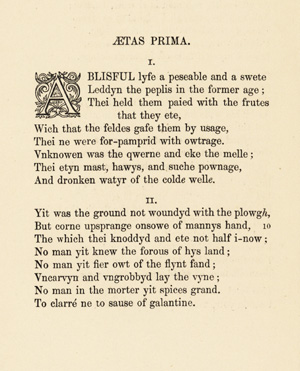ESTABLISHING THE TEXT
 |
| The first printed version of Chaucer’s ‘The former age’, edited by Richard Morris, London, 1866. Morris used MS Hh.4.12 as his copy text, taking the title ‘Ætas prima’ (‘The first age’) from the colophon there. XXIX.10.28. (Printed document not on display.) |
It is possible to forget, when reading a popular edition of an old poet, that the easily-legible words on the printed page have often been derived from manuscript sources at the cost of painstaking labour. To establish reliable texts, as close as possible to their authors' intentions, is the primary task of literary scholarship: without it, the secondary processes of interpretation and analysis have no secure basis.
Editorial methods developed from the Renaissance onwards for the study of classical authors were augmented in the nineteenth century by techniques drawn from the new schools of biblical criticism. The principles of textual criticism remain matters for debate, but manuscripts almost invariably constitute the foundation of the canon for ancient and medieval poets.
Items on display:
MS Add. 4461: Euripides, ‘Iphigenia in Tauris’, Hibei papyrus, c. 280-240 BC, a fragment retrieved from mummy cartonnage. MS Add 6366: Pindar, Olympians, Oxyrhynchus papyrus, fifth or sixth century. MS Kk.5.34: two poems formerly attributed to Virgil, tenth century. MS Ii.3.21: Boethius, ‘Consolatione philosophiæ’, the English translation ascribed to Chaucer, fourteenth century, and MS Hh.4.12: ‘Early English poetry’, fifteenth century, both items open at Chaucer’s poem ‘The former age’, these being the only two texts of the poem surviving from the Middle Ages. MS Add. 6875: A. E. Housman, notes for a lecture on the manuscripts of Catullus, c. 1900.
A sketch diagram by A. E. Housman illustrating the transmission of the text of Juvenal’s satires between 400 and 800 AD. ‘Ar’, ‘S’ and ‘P’ are sigla representing known manuscripts. Reproduced by permission of the Society of Authors as literary representative of the estate of A. E. Housman. MS Add. 6877. (Original document not on display.) |